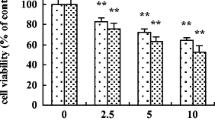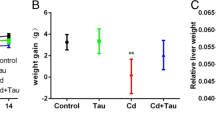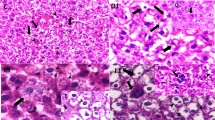Abstract
Exposure to toxic metals and pollutants is a major environmental problem. Cadmium is a metal causing acute hepatic injury but the mechanism of this phenomenon is poorly understood. In the present study, we investigated the mechanism and time-course of cadmium-induced liver injury in rats, with emphasis being placed on apoptosis in parenchymal and nonparenchymal liver cells. Cadmium (3.5 mg/kg body weight) was injected intraperitoneally and the rats were killed 0, 9, 12, 16, 24, 48 and 60 h later. The extent of liver injury was evaluated for necrosis, apoptosis, peliosis, mitoses and inflammatory infiltration in hematoxylin–eosin-stained liver sections, and by assaying serum enzyme activities. The number of cells that died via apoptosis was quantified by TUNEL assay. The identification of nonparenchymal liver cells and activated Kupffer cells was performed histochemically. Liver regeneration was evaluated by assaying the activity of liver thymidine kinase and by the rate of 3H-thymidine incorporation into DNA. Both cadmium-induced necrotic cell death and parenchymal cell apoptosis showed a biphasic elevation at 12 and 48 h and peaked at 48 and 12 h, respectively. Nonparenchymal cell apoptosis peaked at 48 h. Peliosis hepatis, another characteristic form of liver injury, was first observed at 16 h and, at all time points, closely correlated with the apoptotic index of nonparenchymal liver cells, where the lesion was also maximial at 48 h. Kupffer cell activation and neutrophil infiltration were minimal for all time points examined. Based on thymidine kinase activity, liver regeneration was found to discern a classic biphasic peak pattern at 12 and 48 h. It was very interesting to observe that cadmium-induced liver injury did not involve inflammation at any time point. Apoptosis seems to be a major mechanism for the removal of damaged cells, and constitutes the major type of cell death in nonparenchymal liver cells. Apoptosis of nonparenchymal cells is the basis of the pathogenesis of peliosis hepatis. The first peaks of necrosis and parenchymal cell apoptosis seem to evolve as a result of direct cadmium effects whereas the latter ones result from ischemia.









Similar content being viewed by others
References
Blouin A, Bolender RP, Weidel ER (1977) Distribution of organeles and membranes between hepatocytes and nonhepatocytes in rat liver parenchyma. J Cell Biol 72:441–447
Casalino E, Sblano C, Landriscina C (1997) Enzyme activity alteration by cadmium administration to rats: the possibility of iron involvement in lipid peroxidation. Arch Biochem Biophys 346:171–179
Cascales M, Alvarez A, Gasco P, Fernandez Simon M, Sanz N, Bosca L (1994) Cocaine-induced liver injury in mice elicits specific changes in DNA ploidy and induces programmed death of hepatocytes. Hepatology 20:992–1001
Corcoran GB, Fix L, Jones DP, Moslen MT, Nicotera P, Oberhammer FA, Buttyan R (1994) Apoptosis: molecular control point in toxicity. Toxicol Appl Pharmacol 128:169–181
Dong W, Simeonova PP, Gallucci R, Matheson J, Flood L, Wang S, Hubbs A, Luster MI (1998) Toxic metals stimulate inflammatory cytokines in hepatocytes through oxidative stress mechanisms. Toxicol Appl Pharmacol 151:359–366
Dudley RE, Svoboda DJ, Klaassen CD (1982) Acute exposure to cadmium causes severe liver injury in rats. Toxicol Appl Pharmacol 65:302–313
Dudley RE, Svoboda DJ, Klaassen CD (1984) Time-course of cadmium-induced ultrastructural changes in rat liver. Toxicol Appl Pharmacol 76:150–160
El-Azzouzi B, Tsangaris GT, Pellegrini O, Manuel Y, Benveniste J, Thomas Y (1994) Cadmium induces apoptosis in human T cell line. Toxicology 88:127–139
Esteve JM, Mompo J, Garcia De La Asuncion J, Sastre J, Asensi M, Boix J, Vina JR, Pallardo FV (1999) Oxidative damage to mitochondrial DNA and glutathione oxidation in apoptosis: studies in vivo and in vitro. FASEB J 13:1055–1064
Fowler BA (1991) Other toxic effects. In: Friberg L, Elinder C-G, Kjellstrom T, Nordberg GF (eds) Cadmium and health: a toxicological and epidemiological appraisal. CRC Press, Boca Raton FL, pp 159–204
Goyer RA (1996) Toxic effects of metals. In: Klaassen CD (ed) Casarett and Doull's toxicology: the basic science of poisons. McGraw-Hill, New York, pp 691–736
Gudas JM, Fridovich-Keil J, Pardee A (1994) Posttranscriptional control of thymidine kinase messenger RNA accumulation in cells released from G0/G1 phase blocks. Cell Growth Diff 8:421–430
Habeebu SSM, Liu J, Klaassen CD (1998) Cadmium-induced apoptosis in mouse liver. Toxicol Appl Pharmacol 149:203–209
Harstad EB, Klaassen CD (2002) Tumor necrosis factor-α-null mice are not resistant to cadmium chloride-induced hepatotoxicity. Toxicol Appl Pharmacol 179:155–162
Kahn D, Svanas GW, Eagon PK, Makowka L, Podesta L, Chapchap P, Starzl TE, Van Thiel DH (1988) Effect of an antiandrogenic H2 receptor antagonist on hepatic regeneration in rats. J Lab Clin Med 112:232–239
Kayama F, Yoshida T, Elwell MR, Luster MI (1995) Role of tumor necrosis factor-α in cadmium-induced hepatotoxicity. Toxicol Appl Pharmacol 131:224–234
Kotsonis FN, Klaassen CD (1997) Toxicity and distribution of cadmium administered to rats at sublethal doses. Toxicol Appl Pharmacol 41:667–680
Kyprianidis KG, Mykoniatis MG, Papadimitriou DG, Valsamidou CM (1996) Effect of subtotal pancreatectomy on the rate of liver regeneration: the role of Hepatic Stimulator Substance. J Surg Res 62:267–272
Laster SM, Woods JG, Gooding LR (1998) Tumor necrosis factor can induce both apoptotic and necrotic forms of cell lysis. J Immunol 141:2629–2634
Ledda-Columbano GM, Coni P, Curto M, Giacomini L, Faa G, Olivero S, Piacentini M, Columbano A (1991) Induction of two different modes of cell death, apoptosis and necrosis, in rat liver after a single dose of thioacetamide. Am J Pathol 139:1099–1109
Leist M, Gantner F, Naumann H, Bluethmann H, Vogt K, Brigelius-Flohe R, Nicotera P, Volk HD, Wendel A (1997) Tumor necrosis factor-induced apoptosis during the poisoning of mice with hepatotoxins. Gastroenterology 112:923–934
Liu J, Kershaw WC, Liu YP, Klaassen CD (1992) Cadmium-induced hepatic endothelial cell injury in inbred strains of mice. Toxicology 75:51–62
Lohmann RD, Beyersmann D (1994) Effects of zinc and cadmium on apoptotic DNA fragmentation in isolated bovine liver nuclei. Environ Health Perspect 102:269–271
Lopez-Ortal P, Souza V, Bucio L, Gonzalez E, Ruiz-Gutierrez C (1999) DNA damage produced by cadmium in a fetal hepatic cell line. Mutat Res 439:301–306
Lowry O, Rosenbrough N, Farr A, Randall R (1951) Protein measurement with the Folin phenol reagent. J Biol Chem 193:265–275
Margeli A, Theocharis S, Skaltsas S, Skopelitou A, Mykoniatis M (1994) Effect of cadmium on liver regeneration after partial hepatectomy in rats. Environ Health Perspect 102:273–276
McKim JK, Liu J, Liu YP, Klaassen CD (1992) Distribution of cadmium chloride and cadmium-metallothionine to liver parenchymal, Kupffer and endothelial cells: their relative ability to express metallothionine. Toxicol Appl Pharmacol 112:324–330
Motoyama S, Minamiya Y, Saito S, Saito R, Matsuzaki I, Abo S, Inaba H, Enomoto K, Kitamura M (1998) Hydrogen peroxide derived from hepatocytes induces sinusoidal cell apoptosis in perfused hypoxic rat liver. Gastroenterology 114:153–163
Muller L, Ohnesorge FK (1984) Cadmium-induced alternation of the energy level in isolated hepatocytes. Toxicology 31:297–306
Muller L, Stacey NH (1998) Subsellular toxicity of low level cadmium in rats: effect on cytochrome c oxidase. Toxicology 51:25–32
Munro H, Fleck A (1966) Recent developments in the measurement of nucleic acids in biological materials. Analyst 91:78–88
Nolan CV, Shaikh ZA (1986) The vascular endothelium as a target tissue in acute cadmium toxicity. Life Sci 39:1403–1409
Page AL, Al-Amamy MM, Chang AC (1986) In: Foulkes EC (ed) Cadmium: cadmium in the environment and its entry into terrestrial food chain crops. Springer-Verlag, Berlin Heidelberg New York, pp 33–74
Ray SD, Jena N (2000) A hepatotoxic dose of acetaminophen modulates expression of BCL-2, BCL-X(L), and BCL-X(S) during apoptotic and necrotic death of mouse liver cells in vivo. Arch Toxicol 73:594–606
Richards G (1974) Modifications of the diphenylamine reaction giving increased sensitivity and simplicity in the estimation of DNA. Anal Biochem 57:369–376
Rikans LE, Yamano T (2000) Mechanisms of cadmium mediated-acute hepatotoxicity. J Biochem Mol Toxicol 14:110–117
Saplakoglu U, Iscan M, Iscan M (1997) DNA single-strand breakage in rat lung, liver and kidney after single and combined treatments of nickel and cadmium. Mutat Res 394:133–140
Sauer JM, Waalkes MP, Hooser SB, Kuester RK, McQueen CA, Sipes IG (1997) Suppression of Kupffer cell function prevents cadmium induced hepatocellular necrosis in the male Sprague-Dawley rat. Toxicology 121:155–164
Searle J, Kerr JFR, Bishop CJ (1982) Necrosis and apoptosis: distinct modes of cell death with fundamentally different significance. Pathol Annu 17:229–259
Taxy JB (1978) Peliosis: a morphologic curiosity becomes an iatrogenic problem. Hum Pathol 9:331–340
Wyllie AH, Kerr JF, Currie AR (1980) Cell death:the significance of apoptosis. Int Rev Cytol 68:251–306
Yamano T, Shimizu M, Noda T (1998) Age-related change in cadmium-induced hepatotoxicity in wistar rats: role of Kupffer cells and neutrofils. Toxicol Appl Pharmacol 151:9–15
Yamano T, DeCicco LA, Rikans LE (2000) Attenuation of cadmium-induced liver injury in senescent male Fischer 344 rats: role of Kupffer cells and inflammatory cytokines. Toxicol Appl Pharmacol 162:68–75
Zafrani ES, Cazier A, Baudelot AM, Feldmann G (1984) Ultrastructure lesions of the liver in human peliosis: a report of 12 cases. Am J Pathol 114:349–359
Author information
Authors and Affiliations
Corresponding author
Rights and permissions
About this article
Cite this article
Tzirogiannis, K.N., Panoutsopoulos, G.I., Demonakou, M.D. et al. Time-course of cadmium-induced acute hepatotoxicity in the rat liver: the role of apoptosis. Arch Toxicol 77, 694–701 (2003). https://doi.org/10.1007/s00204-003-0499-y
Received:
Accepted:
Published:
Issue Date:
DOI: https://doi.org/10.1007/s00204-003-0499-y




